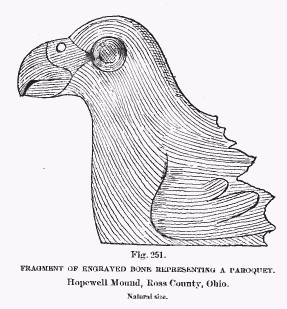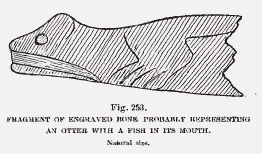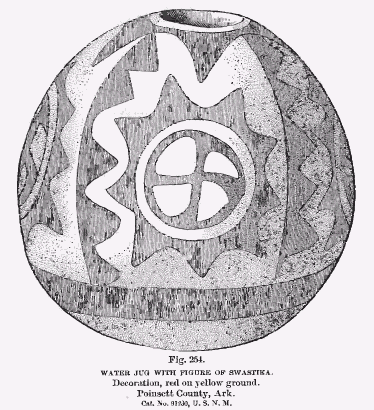

The Swastika
Dispersion of the Swastika
 the
altar had been charred throughout. It contained, in part, mica ornaments,
beads, spool-shaped objects, whale, bear, and panther teeth, flint knives,
carved effigies of bone and stone, some of which were broken, while others
were whole. There were stone tablets, slate ornaments, copper balls, fragments
of cloth, rings of chlorite, quartz crystals perforated and grooved, and
a few pieces of flint and obsidian, with several thousand pearls drilled
for suspension. These objects were heaped in the cavity of the altar without
any regularity. All were affected by heat, the copper being fused in many
cases. The teeth and tasks were charred, split, and calcined, There were
no ashes. All the fuel was charcoal, and form the appearance
the
altar had been charred throughout. It contained, in part, mica ornaments,
beads, spool-shaped objects, whale, bear, and panther teeth, flint knives,
carved effigies of bone and stone, some of which were broken, while others
were whole. There were stone tablets, slate ornaments, copper balls, fragments
of cloth, rings of chlorite, quartz crystals perforated and grooved, and
a few pieces of flint and obsidian, with several thousand pearls drilled
for suspension. These objects were heaped in the cavity of the altar without
any regularity. All were affected by heat, the copper being fused in many
cases. The teeth and tasks were charred, split, and calcined, There were
no ashes. All the fuel was charcoal, and form the appearance  of
the débris, especially the wood, earth, and bone, one might suppose
that after the fire had started it had not been allowed to burn to ashes
as if in the open air, but had been covered with earth, and so had smoldered
out as in a charcoal pit.
of
the débris, especially the wood, earth, and bone, one might suppose
that after the fire had started it had not been allowed to burn to ashes
as if in the open air, but had been covered with earth, and so had smoldered
out as in a charcoal pit.Evidence was found of an extended commerce with distant localities, so that if the Swastika existed in American it might be expected here. The principal objects were as follows: A number of large seashells (Fulgur) native to the southern Atlantic Coast 600 miles distant, many of them carved; several thousand pieces of mica from the mountains of Virginia or North Carolina, 200 or more miles distant; a thousand large blades
 of
beautifully chipped objects in obsidian, which could not have been found
nearer than the Rocky Mountains, 1,000 or 1,200 miles distant; four hundred
pieces of wrought copper, believed to be from the Lake Superior region,
150 miles distant; fifty-three skeletons, the copper headdress (pl.13)
made in semblance of elk horns, 16 inches high, and other wonderful things.
Those not described have no relation to the Swastika.
of
beautifully chipped objects in obsidian, which could not have been found
nearer than the Rocky Mountains, 1,000 or 1,200 miles distant; four hundred
pieces of wrought copper, believed to be from the Lake Superior region,
150 miles distant; fifty-three skeletons, the copper headdress (pl.13)
made in semblance of elk horns, 16 inches high, and other wonderful things.
Those not described have no relation to the Swastika.These objects were all prehistoric. None of them bore the slightest evidence of contact with white civilization. The commoner objects would compare favorably with those found in other mounds by the same and other investigators. Much of it
 may
be undetermined. It is strange to find so many objects brought such long
distances, and we many not be able to explain the problem presented; but
there is no authority for injecting any modern or European influence into.
By what people were these made? In what epoch? For what purpose? What
did they represent? How did this ancient, curious, and widespread sign,
a recognized symbol of religion of the Orient, find its way to the bottom
of one of the mounds of antiquity in the Scioto Valley? These are questions
easy to ask but difficult to answer. They form some of the riddles of
the science of prehistoric anthropology.
may
be undetermined. It is strange to find so many objects brought such long
distances, and we many not be able to explain the problem presented; but
there is no authority for injecting any modern or European influence into.
By what people were these made? In what epoch? For what purpose? What
did they represent? How did this ancient, curious, and widespread sign,
a recognized symbol of religion of the Orient, find its way to the bottom
of one of the mounds of antiquity in the Scioto Valley? These are questions
easy to ask but difficult to answer. They form some of the riddles of
the science of prehistoric anthropology. Mounds in Arkansas. --- A water jug in the collection of the U. S. National Museum (fig. 254) was obtained in 1883 by P. W. Norris, of
<< Previous Page Next Page >>
© 2004-2007 Northvegr.
Most of the material on this site is in the public domain. However, many people have worked very hard to bring these texts to you so if you do use the work, we would appreciate it if you could give credit to both the Northvegr site and to the individuals who worked to bring you these texts. A small number of texts are copyrighted and cannot be used without the author's permission. Any text that is copyrighted will have a clear notation of such on the main index page for that text. Inquiries can be sent to info@northvegr.org. Northvegr™ and the Northvegr symbol are trademarks and service marks of the Northvegr Foundation.

|